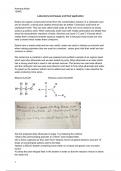Essay
4B - Laboratory techniques and their application DISTINCTION
- Institution
- PEARSON (PEARSON)
I was graded a distinction in all my applied science units, my assignments are extremely well written and contain all the information and pictures you need. If you have any questions do not hesitate to contact me :)
[Show more]



